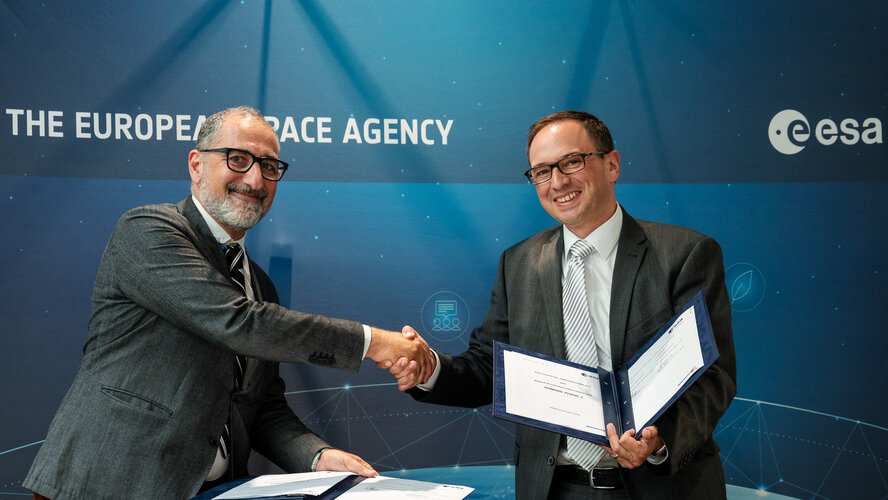Laurent Jaffart, ESA Director of Connectivity and Secure Communications Directorate (CSC) signed the contract with Arlen Kassighian, Chief Engineering Officer (CEO) at Eutelsat Group at an event held at the ESA headquarters in Paris, France.
“I am very pleased to be here, as new Director of CSC at ESA, sharing with our Partner Eutelsat Group an important milestone with the signature of the contract for phase 3 of the Sunrise Partnership Project. ESA is proud to support the space industry in Europe to bring such innovation to the competitive global telecommunications market,” said Laurent Jaffart.
In 2018, ESA started a long and fruitful cooperation with telecommunications operator OneWeb, under the ESA Sunrise Partnership Project to prepare for the next ambitious generation of the OneWeb low Earth orbit (LEO) constellation, with support from the UK Space Agency.
Craig Brown, Investment Director at the UK Space Agency said: “We’re proud to support the Sunrise partnership which has brought together a range of UK companies and European partners to develop the next generation of satellite communications technology. This new phase will continue to build on the capability, capacity and sustainability of Eutelsat Group’s OneWeb’s constellation and catalyse further investment into the commercial space sector.”
The first phase focused the identification and evaluation of new and innovative technologies and services for the OneWeb system.
The second phase was dedicated to the maturation and validation on ground and in orbit of key technologies for the Oneweb next-generation constellation, ranging from digital payloads, to a multibeam Gateway antenna and user terminals, up to end-to-end connectivity demonstrations in 5G.
A key highlight was the launch of JoeySat in May 2023. JoeySat has since supported an extended one year test campaign with excellent results on beam hopping and beam tracking with promising performances in 5G connectivity.
In 2023, OneWeb merged with geostationary operator Eutelsat to form Eutelsat Group. Eutelsat Group’s next generation LEO system deployment adopts a stepwise approach with Sunrise Phase 3 focusing on critical developments, in answer to Eutelsat Group’s next generation needs in terms of technical solutions and services. Moving from prototyping in Phase 2 to production paves the way to a smooth transition to in-orbit demonstrations in 2026.
Commenting on this new phase, Arlen Kassighian, Chief Engineering Officer for Eutelsat Group, said: "Eutelsat Group is very excited to open this new phase of the Sunrise Partnership Program with ESA that underscores our commitment to pushing the boundaries of satellite technology and driving innovation in the space industry. This is an exciting opportunity to work once again with talented potential partners on the development and derisking of cutting-edge technologies for Next Gen and to maintain the competitiveness of the European space industry as a whole.
“We pivoted to an incremental approach for the roll out of our Next Generation system, thus we are committed to maintain consistency between our technological roadmap and the Sunrise programme. In that framework, we intend to use it as a launchpad for continuous improvement to this third and possible future phases and we are delighted with the support from ESA, UK Space Agency and Romanian Space agency to grow this continuous innovation ecosystem.”
The Sunrise Partnership Project demonstrates the ambition of Eutelsat Group, the industrial partners and ESA, to offer unparalleled seamless commercial telecom connectivity services on a global scale, based on cutting-edge technologies while adopting an efficient ‘new space’ approach. It will allow European Industry to be a major player in the very competitive 5G deployment race, providing access to a large, creative, and dynamic market and to new telecom opportunities.
“I would like to thank our delegates for their continuous support, congratulate Eutelsat Group, all your industrial partners and our teams for the fantastic work done so far,” concluded Laurent Jaffart.



